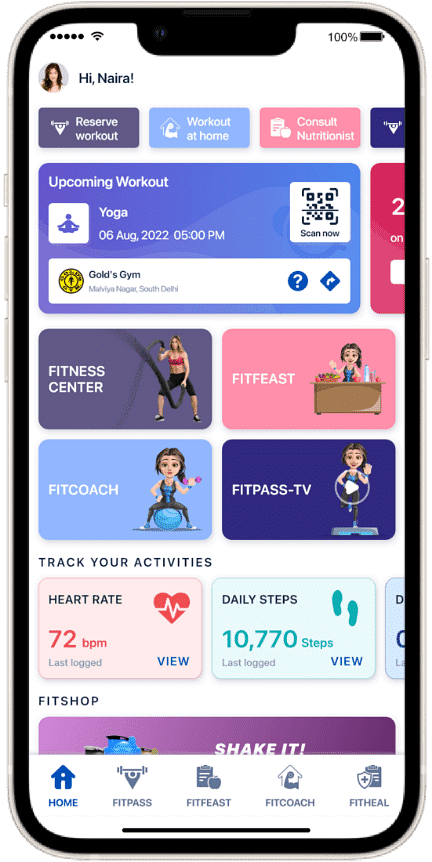10 Essential Strength Training Tips For Beginners
Table of Contents
Strength training or weightlifting can be a little unnerving when you’re new to it. “Which machines should I use?” or “Which exercises will suit me?” can be more than a little confusing. It is an important part of fitness to build strength, especially if you’re working towards a set goal. You don't have to, however, bench press like professionals but minimal strength training will substantially improve your health and physique/figure.
Strength training is not only about strength; it builds self-esteem and confidence. It improves bone density, heart health, and reduces anxiety apart from burning calories. Weightlifting helps in improving balance and reducing the risk of osteoporosis and regulates blood pressure.
Wrong positions and heavy weights can cause injuries. Weightlifting should not be done without the supervision of trained professionals. Join FITPASS and be a part of an integrated fitness community. Choose from 3,500 fitness centers across 12 major cities of India. Get personalized fitness routines and dynamic workout recommendations with A.I.-based fitness coach – FITCOACH.
10 Strength Training Tips for Beginners

Any workout should be preceded by a proper warm-up. For an effective strength training session, start by foam rolling your muscles; it loosens up tense muscles and improves movement. A good warm-up is essential to prepare your muscles for the upcoming workout and improve the range of motion. This allows you to fully extend the muscles for better results. Warm-up allows you to push yourself harder and reduces the risk of injury.

Weight training for weight loss or muscle building is based on using resistance to make your muscles work. You do not necessarily need to use the weights or other weight training equipment right away; you can use your bodyweight. Bodyweight workouts are widely used as effective ways to build strength. Even simple exercises like squats and push-ups without weight are quite effective. Gradually, you can use dumbbells, resistance bands, kettlebells, medicine balls, and slider disks. However, starting with bodyweight exercises is best. Nonetheless, don’t refrain from challenging yourself.

Proper form and technique are indispensable to prevent injuries. Using proper technique ensures that the right muscles are being trained without any strain. Consulting a trainer is a must before lifting weights. The trainer will help you with the position, grip, and motion apart from advising you on the list of exercises best for you. Otherwise, you can peruse the plethora of content online to learn the right form and techniques.

Ideally, you should start with 2 days for the first 2 weeks and then make it 3 days. It is recommended to train 5 days per week to reap weight training benefits but it might strain your body at first. Expert trainers suggest that you should start with 20-minute sessions and add 10 minutes until you reach your highest potential. Starting weight training doesn’t mean that you’ll skip cardio. Include 75-150 minutes of light aerobic exercises per week in your routine.

A full body workout is better for beginners going to the gym 3-4 times a week. Splitting up your body parts according to days is counterproductive if you don’t workout regularly. Therefore, do not start with a chest day or leg day. Full body workout benefits include maximum calories burned and muscles worked.
Pair one upper body exercise with a lower body exercise. The upper and lower parts of the body get the much-required time to recover while you exercise the other half. Trainers will advise you to maintain a balance between pushing and pulling movements as well. For example, you can do squats with push-ups, walking lunges with lateral pull-downs, etc.

Let us suppose you’re doing squats followed by push-ups. So, perform 15 squats and then do 15 push-ups. However, take a rest of up to 30-45 seconds before starting again. Perform the squat push-up duo 3 times. Take a little breather and then move on to walking lunges and lateral pull-downs. Perform 8-15 repetitions depending on your ability. However, you should push yourself as much as you can. There are several variations for different goals, which can be implemented once you get into the groove of strength training.

You will need to experiment a little to figure out how much weight you should lift for each given exercise. Logically, it is better to make strength training workout mistakes with lighter weights than heavier. Gradually increasing weight, let’s say while performing biceps curl is essential to get the best results. Your arms should feel fatigued by the time you begin the last set. However, extreme discomfort is not normal and you should consult a trainer on the weight.

Concluding the weightlifting session with a stretch can maximize strength-training benefits. Stretch your muscles while they’re warm; this will improve flexibility and make you feel even better after lifting all those weights (including your body). It works as a cool-down, which calms down the nervous system. Include dynamic stretching after a weight lifting workout.

The body needs to be hydrated after each workout; drink lots of water after each session. Take a balanced meal after a workout. Do not forget to add carbs to get the needed glycogen – a source of energy. Protein is also essential for muscle building. Even if you’re doing strength training for weight loss, take enough calories. However, don’t let the post-workout meal exceed 150-200 calories.

You will experience a little muscle soreness in addition to tiredness after the workout. Each strength-training workout leads to minuscule breaks in the muscle tissue, which must be repaired by eating right and resting. Even sleeping well and enough each night is essential. If you workout without allowing your muscles to repair, the process might be elongated and you might even incur injuries. In the end, listen to your body and how you feel. If you feel you need rest, then just rest.


